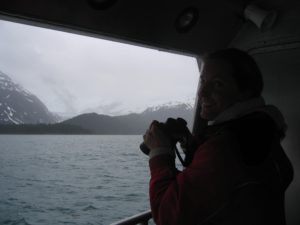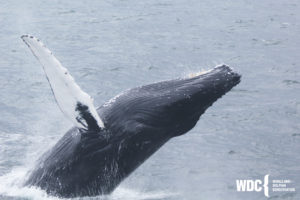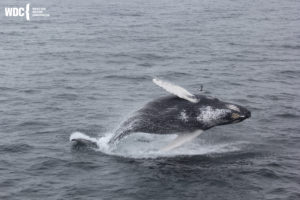Author – Philippa Brakes (@PBrakes)
Whales perform some of the longest migrations on earth. Many live in close family groups, some sing, feed cooperatively, transmit innovations, share the care of their offspring and are even vital ecosystems engineers. They are the stuff of legend and the cornerstone of many marine eco-tourism businesses around the world. Yet despite the size of these charismatic megafauna, both in life and in our imaginations, they remain somehow enigmatic: the details of their lives are challenging for us to grasp. Nevertheless, through long-term studies, we are starting to unravel some of the mysteries and these scientific insights also necessitate a re-evaluation of how best to conserve these giants of the deep.
Behaviour matters. One key issue for the conservation of whales – and likely many other taxa – is social learning. There is growing evidence that many species of whales learn some important behaviours from their elders and sometimes their peers. Evidence for social learning in whales is found in all the main behavioural domains; from communication to foraging, migration to play. This is significant for conservation efforts. Understanding that behaviours from foraging strategies to migration routes may be socially transmitted, requires us to reflect on the types of resources whales need to survive and thrive in ever changing environments.
The emerging evidence in this field is also now beginning to influence conservation policy. The UN Convention on Migratory Species (CMS) has been spearheading important work in this area. At a Conference of the Parties in the Philippines late last year, CMS committed to further examine the importance of social learning for the conservation of a range of migratory species. CMS also agreed a concerted action for the acoustic clans of eastern tropical Pacific sperm whales, which requires cooperation among the range states to gather more information about the social behaviours of these whales.

The better we understand social networks, the types of relationships individuals have, how they innovate and share new information and the roles that specific individuals may play within their social groups, the better equipped we will be for bespoke conservation solutions for animals that learn socially. A key area of importance to conservation will be determining how foraging strategies are socially transmitted. If information about a new technique for foraging on a specific resource is transmitted within a social group, these individuals may become specialist feeders on a particular prey type. Potentially, this has both conservation and evolutionary advantage, if this behaviour results in more efficient prey gathering or provides access to more abundant or better quality prey. However, such specialisation is not without risk. A significant decline in a certain prey type may present a challenge to the survival of some specialist feeders, unless of course they readily swap to other types of prey.
This ability to swap behaviour may be key. For example, bottlenose dolphins have the capacity to socially transmit new foraging strategies. But this species also exhibits sufficient behavioural plasticity to diversify to other prey types when their environment changes and certain prey become scarce. In contrast, killer whales, who are considered more conservative in their behaviour, generally adhere rigidly to their prey specialisations throughout their lifetime. There may be a tension between conservatism and plasticity, both within individual behaviour and across species, which highlights the complexity of conserving animals that learn socially.

But social learning is not the whole story; social structure, social role and even distribution of consistent individual difference (or personality) may also have an influence on the trajectory of populations. To examine this further WDC (@WHALES_org) and #ExeterMarine (@ExeterMarine) are investigating a feeding innovation in humpback whales off Cape Cod in the U.S.A., with the kind help of amazing WDC North America interns. Here, as well as bubble net and lunge feeding, a group of humpback whales have learnt a unique feeding strategy called kick or lobtail feeding. These whales lift the tail fluke (or entire caudal peduncle) out of the water in order to strike the water hard with the tail fluke (at least once) to stun the sand lance. This is typically followed by the whales then corralling the stunned fish by blowing bubbles underwater and surfacing with a mouthful of seawater and fish, which is then strained through the baleen.
This foraging strategy is unique to the Gulf of Maine population of humpback whales. Previous research has determined this behaviour has been socially transmitted between whales in this population for nearly three decades. WDC (@WHALES_org) and ExeterMarine (@ExeterMarine) are now exploring whether factors such as age or social position matter when learning these new foraging skills. Is success rate related to whom you learn from, or are some individuals more predisposed to try out new innovations? Do some whales perfect their technique more rapidly than others, does skill level increase over time? Or, are particular individual differences in feeding style consistent over a lifetime? Do some whales never quite get the hang of the optimal kick feeding style and does that influence their overall calorific intake, their reproductive success, or even their longevity?
Our research so far indicates that individual whales exhibit their own specific styles of kick feeding, the question is how and if these styles change over time. Another interesting discovery is that some whales in this group seem to be goal hangers! There may be a producer-scrounger system in operation among these whales, although how dynamic this situation is remains to be seen. Non-kicking ‘scroungers’ may be benefiting from feeding on the fish stunned by the kicking whales. This begs several questions. Does it pay sometimes to be a kicker (producer) and sometimes a scrounger? Or is this part of the process of learning this unique foraging strategy? Does scrounging behaviour vary with group size? Are there ecological constraints? Only by gathering data on how these individual whales feed will we gain a better understanding of how these systems work and what role consistent individual difference may play in the spread of social learning of particular foraging strategies.
We can look to other taxa for clues. For example, chimpanzees exhibit gender differences in learning, particularly in relation to attention to maternal techniques, which has been used to predict competence in learned behaviour at a later date. Understanding whether similar differences between males and females exist in humpback whales will enable a richer understanding of social transmission in these species.
One thing is certain: whale science has advanced considerably since the save the whale movement of the 70s and 80s. Contemporary efforts to conserve whales from human-induced rapid environmental change requires more sophisticated and strategic approaches to protecting populations, which in some cases includes defining and managing social units. Saving whales today requires us to rethink some traditional approaches for delineating populations and shine a light on some of the detail of their individual lives. Just as ecological and conservation thinking has evolved from the elementary description of basic food chains, towards grappling with the complexity of food webs, future conservation efforts will need to incorporate the many facets of the social, as well as ecological, aspects of the life histories of these leviathans.
#ExeterMarine is a interdisciplinary group of marine related researchers with capabilities across the scientific, medical, engineering, humanities and social science fields. If you are interested in working with our researchers or students, contact Michael Hanley or visit our website!
